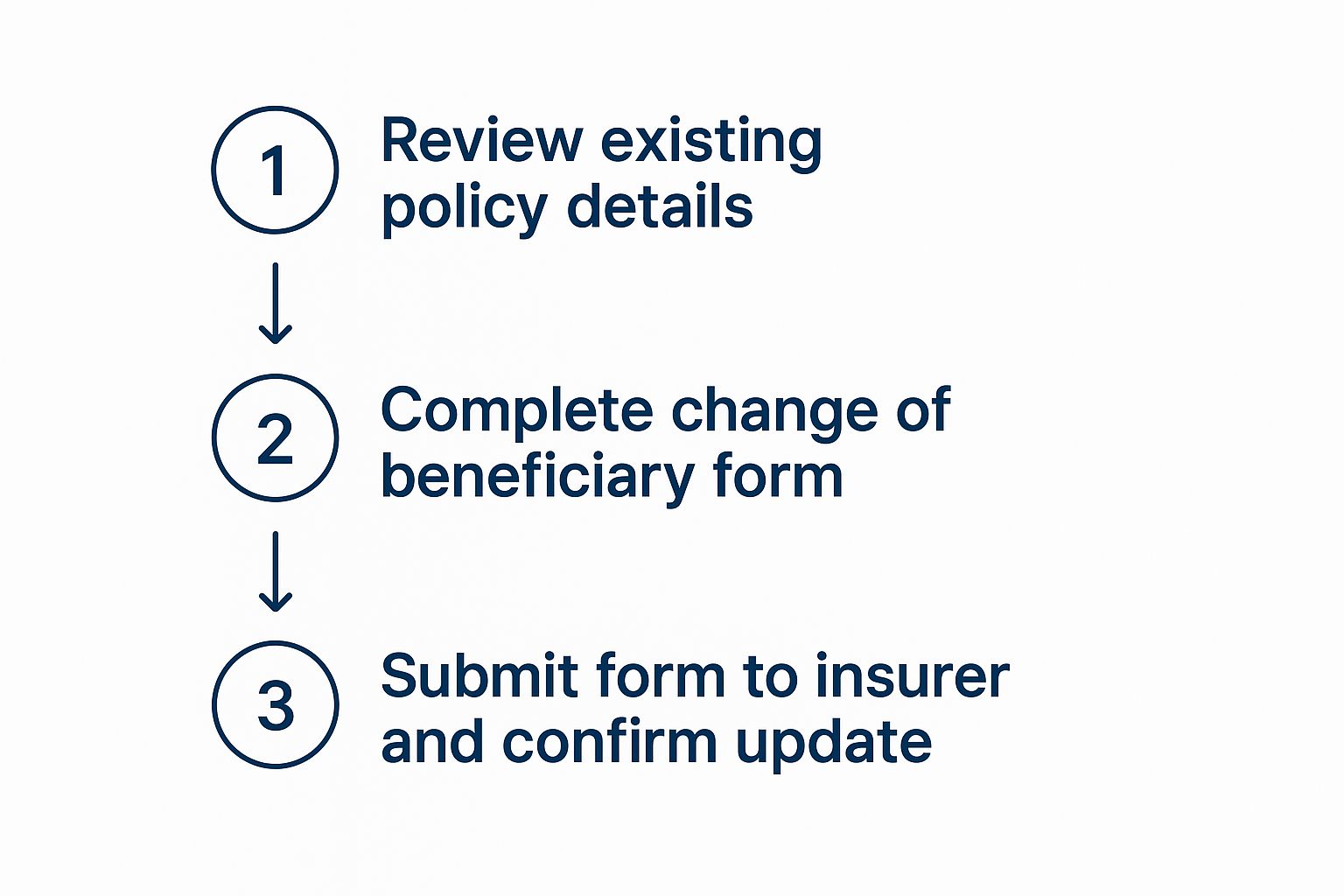Changing Life Insurance Beneficiary: Expert Guide & Tips
- dustinjohnson5
- Jul 14
- 11 min read
Changing your life insurance beneficiary is a straightforward process, but one that’s incredibly easy to overlook. You can usually get it done by grabbing a "Change of Beneficiary" form from your insurer or, even easier, by logging into their online portal. Taking this simple step is the only way to guarantee your death benefit goes to the right people when they need it most.
Don't Let an Outdated Policy Derail Your Plans
Think of your life insurance as more than just a policy; it's a promise you've made to care for your loved ones. But that promise can quickly unravel if your beneficiary information is out of date.
I've seen it happen. A client finalizes a divorce, and in the whirlwind of paperwork and emotional stress, they forget to update their policy. Years later, they pass away, and their ex-spouse—not their children or new partner—is legally entitled to the entire death benefit. What follows is almost always a prolonged and painful legal fight for the people who were meant to be protected.
This isn't just a worst-case scenario; it's a real consequence of a simple oversight.
Life Changes Mean It's Time for a Policy Check-In
Think of major life events as built-in reminders to check on your policy. These moments are natural triggers to make sure your financial safety net is still set up to protect the right people.
It’s time for a review after:
Getting married or divorced: Your legal and personal relationships have fundamentally changed. Your policy needs to reflect your new reality.
Welcoming a child: Whether by birth or adoption, a new dependent needs to be included in your financial plan.
The death of a beneficiary: If your primary beneficiary passes away, you must name a new one. Otherwise, the proceeds could get tied up in probate court.
A minor beneficiary comes of age: Once a child turns 18, you can often remove the named custodian and designate them directly, simplifying the process for them down the road.
Ignoring this is a bigger gamble than you might think. Shockingly, surveys show that nearly 30% of American life insurance policyholders don't update their beneficiaries after a major life event. That's a huge gap in financial planning that leaves families vulnerable.
To ensure your life insurance aligns with your broader financial goals, such as exploring ways to build generational wealth, regularly reviewing your beneficiaries is crucial. It’s a proactive step that safeguards your legacy and prevents unintended consequences for your family.
Updated Policy vs. Outdated Policy: The Real-World Impact
The difference between a current policy and an outdated one isn't just paperwork—it has profound, real-world consequences for the people you leave behind. This table shows just how different the outcomes can be.
Scenario | With an Updated Beneficiary | With an Outdated Beneficiary |
|---|---|---|
After a Divorce | The new spouse or children receive the death benefit directly and quickly, as intended. | The ex-spouse legally receives the entire benefit, potentially forcing the intended heirs into a costly legal battle. |
After a Child is Born | The new child is listed and their share is protected, often in a trust managed by a guardian. | The newborn is unintentionally excluded. The benefit is split only among the previously named beneficiaries. |
After a Beneficiary Dies | The proceeds pass smoothly to the named contingent (secondary) beneficiaries. | The deceased's share may go to their estate, triggering a lengthy and public probate process. |
As you can see, a few minutes spent updating a form can prevent months, or even years, of heartache and financial chaos for your family. It's one of the most impactful financial decisions you can make.
Getting Clear on Your Beneficiary Options

Before you can update your life insurance policy, you have to get a firm handle on the language your insurance company uses. These aren't just technical terms; they're the precise instructions that dictate how your legacy is passed on. Think of it as creating a clear financial roadmap for your loved ones.
At the heart of it all are two fundamental layers to your beneficiary designation:
Primary Beneficiary: This is your first-in-line recipient. The person, people, or even an entity you name here gets the death benefit. Simple as that.
Contingent Beneficiary: I always call this your "Plan B." If your primary beneficiary has passed away or can't accept the payout for some reason, the money automatically goes to your contingent, or secondary, beneficiary.
I’ve seen it happen: without a contingent beneficiary named, the policy proceeds can get dumped into the deceased's estate. This means the money gets tangled up in the slow, often expensive probate court process, causing major delays and stress for the family. It's a surprisingly common mistake, but thankfully, an easy one to avoid.
Revocable vs. Irrevocable Designations
Here’s another critical fork in the road: is your beneficiary revocable or irrevocable?
For the vast majority of personal policies, the designation is revocable. This is the flexible option. It simply means you, the policy owner, hold all the cards and can change the beneficiary whenever you want, no questions asked and no permission needed.
An irrevocable beneficiary is a whole different ballgame. Naming someone as irrevocable gives them a vested legal right to the death benefit. You literally cannot change or remove them as the beneficiary without getting their signed, written consent. This is much less common, but you'll sometimes see it required as part of a divorce decree or a business agreement.
Key Insight: Getting these roles right is the most important part of the process. A clear line of succession with both primary and contingent beneficiaries is your best defense against legal messes. It ensures the money gets to the right people, right when they need it, without a hitch.
A question I get all the time is about naming children or grandchildren. While you can certainly name a minor, it's not as simple as it sounds, as they can't legally receive a direct payout. If this is part of your plan, you'll need to know the specific rules. You can get a good overview by exploring the question, Can Minors Be Life Insurance Beneficiaries?
Don't ever underestimate the impact of this decision. In 2023, the average life insurance payout in the U.S. was a significant $185,000. For joint policies, that figure jumped to $320,000. That's a life-changing amount of money that provides real financial security, and it's why getting the beneficiary details perfect is so important.
Your Action Plan for Updating Your Beneficiary
Alright, now that we've covered the key players in your policy, it's time to roll up our sleeves and get this done. Changing your life insurance beneficiary is one of those small tasks that delivers immense peace of mind, and you can usually knock it out in an afternoon.
First things first: you need your policy information. If you're organized, you might have the original documents filed away. Grab them. You're looking for your policy number and the insurer's contact details.
Can't find the paperwork? Don't sweat it. Just head to your insurance company's website or give their customer service line a call. They can get you started.
Choosing Your Method: Online vs. Paper
Most insurers these days give you a couple of ways to handle beneficiary updates. Which route you take really just boils down to your own comfort level and how your specific company is set up.
The Online Portal: This is almost always the quickest, most straightforward path. You simply log into your account, navigate to the "beneficiaries" or "policy details" section, and follow the prompts. The big advantage here is the instant gratification—you'll usually get an immediate digital confirmation that your change has been logged.
The Paper Form: If you're more of a pen-and-paper person, or if your insurer's online system feels a bit clunky, you'll need to request a Change of Beneficiary form. You can typically download a PDF from their website or have them mail a physical copy to you. This method just requires a bit more attention to detail.
A Quick Pro Tip: When you're filling out a paper form, accuracy is king. I can't stress this enough. Double-check every single detail—the spelling of names, Social Security numbers, and dates of birth. A simple typo can create major headaches and delays for your loved ones down the road.
This infographic breaks down the core process into a few simple stages, from the initial review to the final confirmation.

As you can see, it's a manageable process that puts you firmly in control of where your benefits go.
Submitting and Confirming the Change
Once the form is filled out, whether you did it online or on paper, you've reached the final step: submission.
If you made the change online, clicking "submit" is usually the end of it. But if you have a physical form, don't just drop it in the mail. I always advise my clients to send it via certified mail with a return receipt requested.
This isn't just being overly cautious; it's about creating a legal paper trail. That little green return receipt card you get back in the mail is your concrete proof that the insurance company received your updated instructions on a specific date. This small, inexpensive step can prevent a world of trouble and ensure your wishes are followed to the letter.
Side-Stepping Common Beneficiary Mistakes

A simple clerical error today can easily blossom into a massive legal and emotional headache for your family tomorrow. When you're changing life insurance beneficiary designations, precision is everything. Vague instructions are an open invitation for disputes, so your goal needs to be crystal clear.
One of the most frequent mistakes I see is people naming beneficiaries with generic descriptions like "my children." It seems straightforward, but it can quickly become a legal quagmire. Does that term include step-children, adopted children, or a child born after you signed the form? You should always name each person individually using their full legal name to remove any doubt.
Another critical oversight is forgetting to name a backup, or contingent, beneficiary. This is a gamble you really don't want to take. Without a contingent beneficiary, if your primary designee passes away before you, the death benefit defaults to your estate. That means the funds get tied up in probate court, become public record, and are exposed to creditors.
Key Takeaway: The whole point of a life insurance policy is to protect your loved ones, not burden them. Precision in naming individuals and setting up a clear backup plan are the two most important things you can do to prevent future conflicts and delays.
Confirming the Change and Other Considerations
After you’ve sent in your beneficiary change form, your job isn't quite done. You absolutely must follow up with the insurance company to confirm that the change has been officially recorded. Never assume it was processed correctly. Always request written confirmation for your records.
This step is more than just a formality. Research shows that neglecting beneficiary updates is a widespread problem, with some studies indicating that 15-20% of claims face disputes or delays due to outdated information. You can dig deeper into how outdated beneficiaries impact claims with these life insurance statistics.
Finally, be aware of specific legal situations that can override your beneficiary designation. For instance, if you live in a community property state, your spouse may have a legal claim to a portion of the policy's proceeds, even if they aren't named as the beneficiary. These kinds of nuances make it vital to ensure your changes are not just submitted, but also legally sound.
Finalizing the Change and Securing Your Documents
Once you've sent in the beneficiary change form, it's easy to check that task off your list and move on. But you're not quite done yet. From my experience, the single biggest mistake people make is assuming the change is complete just because they mailed the paperwork.
You need to be proactive. Give it a couple of weeks, then get on the phone with your insurance company. Ask them to send you written confirmation that the beneficiary update has been processed and is now official. This isn't just a piece of paper—it's your proof that the change is legally locked in.
Smart Document Management
When that confirmation letter arrives, don't just toss it in a file drawer. The best thing you can do is physically attach it—staple it, paperclip it—directly to your original life insurance policy. This creates a single, authoritative source of truth and prevents any potential confusion down the road.
Your next step is safekeeping. A locked, fireproof safe in your home is a great option, as is a bank's safe deposit box. The goal is to protect these vital documents from damage or loss.
Crucial Tip: Here’s the part people often forget: you have to tell someone where the documents are. Your new primary beneficiary and the executor of your will absolutely must know the location of your life insurance policy. A quick conversation now can save your loved ones from a world of stress later.
Closing this final communication loop is what makes the whole process work. When you finalize your beneficiary update, you'll often be signing the necessary forms, and taking these last simple steps ensures everything is clear, confirmed, and easy to find. It's how you get real peace of mind, knowing your family will be taken care of exactly as you planned.
Answering Your Top Beneficiary Questions

When you start digging into your life insurance policy, especially the beneficiary designations, a lot of questions tend to pop up. I see it all the time with my clients. Getting the right answers is crucial because these decisions directly impact how well your loved ones are protected.
Let's walk through some of the questions I hear most often.
Can I Name My Minor Child as a Beneficiary?
Technically, yes, you can. But in practice, it’s one of the biggest mistakes you can make.
Life insurance companies can't just hand over a large check to a minor. Doing so triggers a court process where a judge must appoint a legal guardian to manage the money. This isn't just a headache; it's a slow, public, and costly legal battle that eats into the funds meant for your child's future.
A much smarter approach is to set up a structure that avoids court entirely. You have a couple of solid options here:
Create a trust. You can name a trust as the beneficiary of your policy. The trust documents will spell out exactly how you want the money managed and distributed for your child's care, education, and well-being. It gives you maximum control.
Use the UTMA. Another great strategy is to name an adult custodian under your state's Uniform Transfers to Minors Act (UTMA). This lets a trusted adult manage the funds for the child until they come of age, completely bypassing the probate court system.
What If I Don't Name a Beneficiary at All?
This is a critical oversight that can have some pretty serious consequences. If you don't name a beneficiary, the policy’s death benefit gets paid to your estate.
On the surface, that might not sound terrible, but it opens a can of worms. The money is no longer shielded from your creditors and gets tangled up in the public probate process. The biggest problem? It creates a massive delay for your family in getting the funds they need right away.
Expert Insight: When life insurance proceeds go to an estate, they lose their primary advantage—speed and privacy. The money that was meant to provide immediate support can get locked up in legal proceedings for months or even years.
How Often Should I Review My Beneficiaries?
Life changes, and your policy needs to change with it. As a general rule, I tell my clients to pull out their policies and review their beneficiaries at least every two years. Think of it as a routine check-up.
More importantly, you absolutely must review your designations after any major life event. These are the moments that shift your world and your financial responsibilities. We’re talking about things like:
Getting married or divorced
The birth or adoption of a child
The death of a current beneficiary
Keeping your policy aligned with your life is one of the most important things you can do to protect your family's future.
At America First Financial, our whole philosophy is built on providing clear, straightforward protection for your family. If you're ready to secure your legacy with a plan that truly reflects your values, you can get a free, no-hassle quote in under three minutes.
_edited.png)
Comments